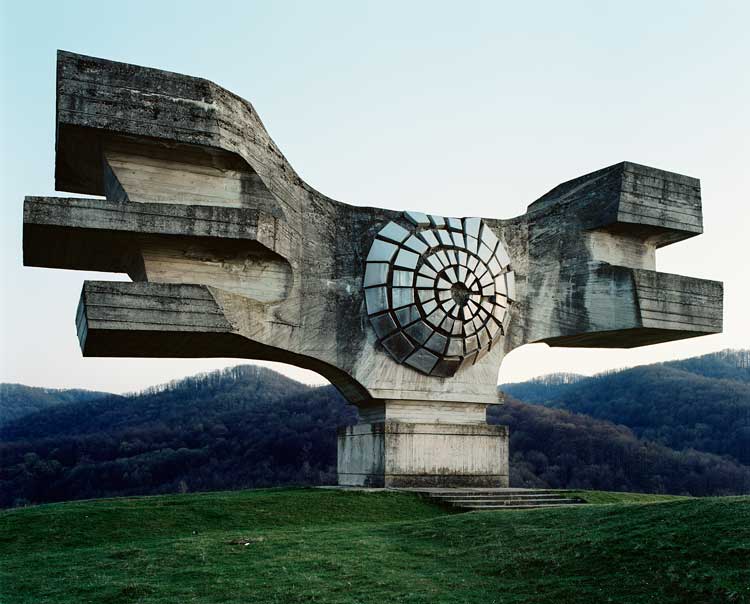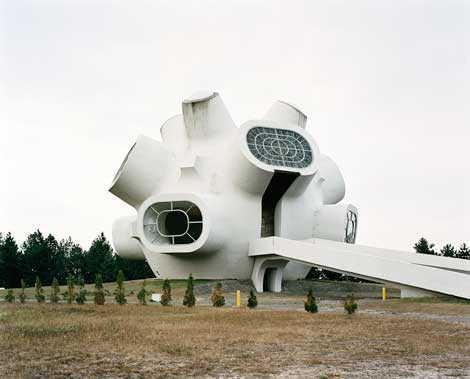In Sarajevo, it only makes sense to remember the day that’s just passed.
—Semezdin Mehmedinović, “What Will You remember?” from Sajevo Blues (San Francisco: City Lights Books, 1998), 67.
What happens when a notoriously heterogeneous people is asked to deny its own fragmented and often violent history, and to repudiate its own complex and contradictory cultural memory in favor of a pristine ideological projection into an alien and impossible future? One set of answers to this question is currently on display at the UCLA Fowler Museum’s small but riveting selection of the Antwerp-based photographer Jan Kempenaers’s “Spomenik: Photographs of the Monuments of Former Yugoslavia,” on extended exhibition through September 22, 2013.
Spomenik is a word in Sebo-Croat that means simply “monument.” The Spomeniks chronicled by Kempenaers over a three-year period (2006-2009), however, are all related historically and ideologically; and they all cohere as a group despite their quite varied appearances: unified by Kempenaer’s beautifully and subtly modulated photographic style. Indeed, one of the delights of the show is that it provides the double pleasure of pondering the extraordinary diversity of the Spomeniks (many of which must provide an incredible on-site experience) as that diversity is unified by Kempenaer’s visual approach, simple in theory yet carefully thought out in every case. Thus, his photos are at once perfectly framed and maximally resonant historical or archival documents, and works that carry a cool, uncomplicated, and powerful beauty in their own right.
The Spomeniks themselves are products of a heroic attempt, almost certainly doomed from its inception, to use the memorialization of enormous and equally heroic sacrifice to forge a unified Yugoslavia from a collection of diverse and mutually antagonistic ethnic, religious and “national” enclaves that had been cobbled together as an independent “state” out of fragments of the shattered Ottoman Empire following the end of World War I. The moving force behind this attempt was Marshall Josip Broz Tito, the hero of the anti-fascist resistance during World War II, and the “President for Life” who saw a vision of Yugoslavia as a non-aligned Socialist state, transcending the ethnic and religious enmities of the past, as well as the East-West antagonism of the Cold War, to emerge as an economically strong, culturally rich, and post-ethnic federation at the center of a revivified Balkans.
Needless to say, all this turned out to be a utopian fantasy. Following Tito’s death in 1980 and then the collapse of the Soviet Union in December, 1991, Yugoslavia itself disintegrated in a cascade of civil war and ethnic cleansing that left hundreds of thousands dead and displaced and lasted into the 21st century. Yet the Spomeniks, at least some of them, remained.
Originally commissioned in the 1960s and ’70s, and mobilizing a huge number of Yugoslav architects, sculptors and designers, the Spomeniks were made to be site-specific, yet otherwise strangely “generic” memorials to the struggle of the [united] Yugoslav people against Nazism and fascism. This program itself required a complex rethinking of historical reality.
In the city of Sarajevo, at the top of Marshall Tito Street, is a conservative, neo-classical niche that records the “jointly spilled blood” of Bosnaian-Herzegovinian, Croatian, Montenegran, and Serbian fighters of the Yugoslav National Army as well as Sarajevan patriots (Serbs, Muslims, and Croats) in the liberation of the city on 6 April 1945. Unfortunately, even this extended roll call glosses over the fact that collaboration with the Nazis (as well as the Soviets) was widespread as was resistance, and that few if any Yugoslav groups had hands clean of the blood of their fellow countrymen.
Nevertheless, Tito’s Spomeniks blossomed like flowers of reconciliation all across the country, in all sizes, shapes, and a number of different materials, if in a fairly restricted and non-floral range of colors. Taken together, even the large ones (the only examples that remain more-or-less intact) display an enormous variety of formal strategies, evocative echoes, emotional resonances. Some appear to derive from alien civilizations, as if miraculously transported across vast gulfs of space or time; some, which are genuinely architectural in form and can be entered, for example, like Washington’s Lincoln or Jefferson Memorials, seem to be the products of radical design seminars working on the fringes of ’70s architecture; some seem totalitarian in their expansive, upward striving sweep (as though they could have been equally at home in Saddam Hussein’s Baghdad); some seem clearly to express the violence, the ravages, and the destructive power of war; some seem overtly commemorative, evoking the absence of the dead or providing shelter and comfort for survivors. All are now abandoned, untended; no longer visited by vast crowds as they had been in the ’70s and ’80s. Many have been vandalized, physically damaged, tagged with graffiti; they have become useless if enduring fragments of a time no longer relevant to most who see them—in that sense, some of them reminded me of the abandoned World War II gun emplacements that dot the Marin headlands north of San Francisco.
Their rural setting adds to the sense of ruination and desolation they evoke, although in Kempenaer’s photos, and I suspect in person, it can also add to a sense of violated majesty: one might be reminded of the so-called Colossi of Memnon, or Shelley’s Ozymandias, or Greek ruins like the temples at Paestum, even of the Picturesque “ruins” that dotted 18th-century English country estates. Yet there is something that separates the Spomeniks from all these potential interpretive touchstones: their connection to an enterprise that while once perhaps seen as a shining ideal (at least by its creators) is now shunned and, after really a quite short span of time, dismissed as what amounts to a historical lie.
In their own time, the Spomeniks were intended to embody a re-imagination of history and a projection of that history into a heroic and triumphant future. Today, they are capable of commemorating neither the sacrifices of those “Yugoslavs” fallen in the fight against fascism—and who would care, for there are no “Yugoslavs” left—nor the vision of those now also dead that originally brought them into being. In that sense, they have been drained of meaning, able to stand or fall as embodiments of some kind of absolute form.
But Kempenaer’s marvelous photos at least at times suggest something else: that far from having escaped history, the Spomeniks themselves are now beings within history. But it is a history that is now local, personal, inscribed in spray paint, embodied in the fugitive caress of lovers, or the way in which a pair of embracing, comforting concrete forms, in framing the whitened trunk of a dead yet standing tree, rhymes culture and nature in an ineffable and really quite magical way.
Ends September 22, 2013; info at fowler.ucla.edu







